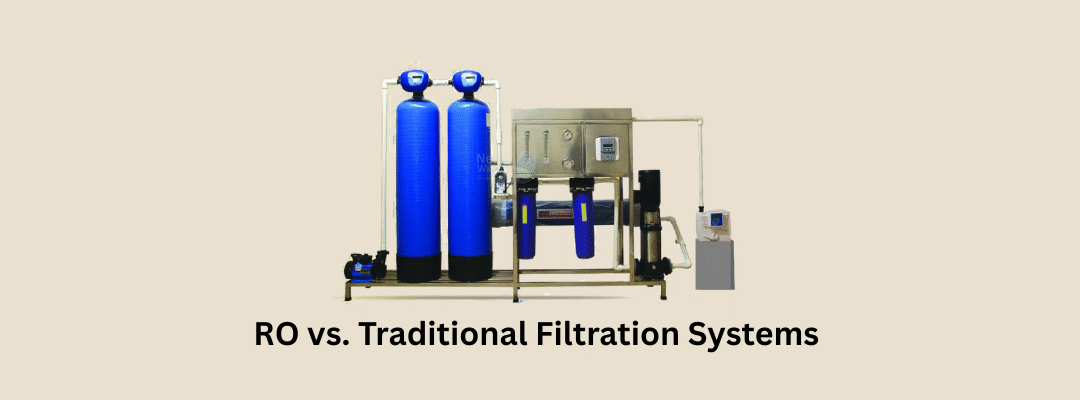Clean and safe drinking water is no longer a luxury — it’s a necessity. With increasing concerns about water quality in homes, offices, and industries, choosing the right purification system has become essential.
When it comes to water filtration, most people are torn between Reverse Osmosis (RO) systems and traditional filtration methods such as activated carbon, sediment, or ceramic filters.
While both options aim to purify water, they differ significantly in technology, effectiveness, and application. This blog compares RO vs. traditional water filtration systems and helps you decide which one suits your needs best.
1. Understanding the Basics
a) What Is an RO Water System?
An RO (Reverse Osmosis) system uses a semipermeable membrane to filter water at the molecular level. It effectively removes dissolved salts (TDS), heavy metals, chemicals, and microorganisms — producing high-purity water.
RO systems are ideal for areas with hard water, high TDS, or chemical contamination, such as borewell or industrial water sources.
b) What Are Traditional Filtration Systems?
Traditional systems such as sediment filters, activated carbon filters, and ceramic filters rely on physical and chemical absorption to trap contaminants. They remove dust, rust, chlorine, and odors but cannot filter out dissolved salts or microbes.
These systems work best in places where municipal water supply is already treated and has low TDS levels.
2. Key Differences Between RO and Traditional Filtration
| Feature | RO Water System | Traditional Filtration System |
|---|---|---|
| Filtration Method | Semipermeable membrane (molecular level) | Physical/chemical (carbon, ceramic, etc.) |
| Removes Dissolved Salts (TDS) | Yes | No |
| Removes Bacteria & Viruses | Yes (with UV/UF support) | Limited |
| Removes Chlorine & Odor | Yes | Yes |
| Suitable Water Source | Borewell, hard water, high TDS | Municipal water, low TDS |
| Maintenance | Moderate (6–12 months filter change) | Low to moderate |
| Taste of Water | Clean, neutral, mineral-balanced | Natural taste retained |
| Electricity Requirement | Yes | No (mostly) |
| Water Recovery | 50–80% (varies by system) | 100% |
| Ideal for | Homes, industries, schools, commercial facilities | Homes with treated municipal water |
3. Advantages of RO Water Systems
a) Superior Purification
RO removes up to 99% of contaminants, including heavy metals like arsenic, fluoride, and lead — ensuring water meets BIS standards for drinking water quality.
b) Ideal for Hard and Borewell Water
Traditional filters cannot manage high TDS or heavy salt content. RO systems are designed for such scenarios and provide clean, safe drinking water.
c) Consistent Water Quality
RO ensures a stable TDS level and water purity, even when source water quality fluctuates seasonally.
Example: A small clinic in Pune installed a 50 LPH RO system to address borewell water hardness. The result? Reduced appliance damage and improved patient safety through better hydration.
d) Enhanced Taste and Odor
RO + carbon filtration improves both taste and odor, delivering refreshing, neutral-tasting water.
e) Safe for Long-Term Health
RO water eliminates waterborne bacteria, viruses, and chemical contaminants — helping prevent chronic exposure risks.
4. Advantages of Traditional Filtration Systems
a) Low Maintenance and Cost
Affordable and easy to maintain — ideal for homes using pre-treated municipal water.
b) Works Without Electricity
Perfect for areas with frequent power outages — offers uninterrupted filtration.
c) Retains Natural Minerals
Because they don’t remove dissolved solids, traditional filters preserve natural minerals in the water.
d) Eco-Friendly Operation
No water is wasted during filtration — a big plus for sustainability-focused households.
5. Which One’s Better for You? (Use-Case Comparison)
| Water Source | Recommended System | Why |
|---|---|---|
| Borewell / Groundwater | RO System | High TDS, chemical or microbial risks |
| Municipal Supply Water | Traditional Filter (UV/Carbon) | Low TDS, requires basic filtration |
| Industrial / Institutional Use | RO Plant | High volume, consistent output needed |
| Rural Areas (Low Pressure) | Gravity / Ceramic Filter | No electricity or plumbing needed |
| Hard Water Areas | RO + UV Combo | Tackles TDS and microbiological load |
6. Combined Systems – Best of Both Worlds
Modern water purifiers often feature RO + UV + UF + Carbon technologies, combining multiple layers of filtration.
Benefits of hybrid systems:
- Remove salts, heavy metals, chemicals, and microbes
- Retain essential minerals using TDS controllers
- Deliver clean, safe, and tasty water across varying seasons and locations
These models are perfect for homes, offices, schools, and small commercial units.
7. Final Verdict
Both RO and traditional filters have their place — the best choice depends on your water source and health priorities.
Choose RO if:
- Your water source has high TDS, hardness, or contaminants
- You need consistent purity and safety for your family or facility
Choose traditional filters if:
- You rely on municipal supply with low TDS
- You prefer low maintenance and minimal water waste
For ultimate protection, consider a hybrid system with RO and mineral balancing.
Frequently Asked Questions (FAQs)
Q1. Is RO purification necessary if I already have a UV or carbon filter?
If your water has high TDS or hardness, UV or carbon filters are not enough — RO is essential.
Q2. Does RO remove useful minerals?
Basic RO systems do, but modern RO models reintroduce minerals through TDS controllers or cartridges.
Q3. Which filtration method is more cost-effective in the long run?
RO systems may cost more initially, but they offer long-term savings by protecting health and appliances.
Q4. Can I combine RO with traditional filters?
Yes. Many purifiers today are hybrid models combining RO + UV + UF + Carbon for complete protection.
Q5. What’s the ideal TDS level for drinking water?
As per BIS standards, the ideal TDS level is below 500 mg/L — which RO systems easily achieve.


Recent Comments